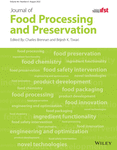Double emulsions containing probiotic cells (Lactiplantibacillus plantarum) added in a mango dessert
Abstract
Due to intolerance and allergy to milk derivatives, different nondairy probiotic products have been developed. However, one of the challenges of this sector is related to the viability of these microorganisms during the storage of products and the passage through the gastrointestinal tract. A possible alternative would be to include probiotic cells in the internal aqueous phase of double emulsions, as these systems could protect cells from adverse conditions by keeping them in sufficient quantities to exert their beneficial effects. Thus, this research's objective was to develop a mango sweet formulation containing probiotic L. plantarum cells included in the internal phase of double emulsions and to study cell viability under simulated gastrointestinal conditions in vitro. The double emulsion protected bacteria from extreme stress in the gastric phase, providing a suitable growth environment. Thus, the inclusion of probiotic cells in nondairy products, such as mango desserts, is of great relevance, meeting consumers' demand restricted to the ingestion of dairy products, and increasing the diversity of probiotic products on the market.
Novelty Impact Statement
Currently, there is a growing interest in the development of nondairy probiotic products. Vegetables, for example, represent good vehicles to carry these bacteria. However, one of the challenges of this sector is related to the viability of these microorganisms during the storage of products and the passage through the gastrointestinal tract. Thus, the production of dessert mango formulation containing probiotic L. plantarum cells included in the internal phase of the double emulsion is a promising approach for encapsulation of this microorganism, representing a novel alternative for application in the development of biofunctional foods.
Open Research
DATA AVAILABILITY STATEMENT
Data available on request from the authors: The data that support the findings of this study are available from the corresponding author upon reasonable request




